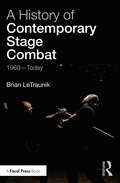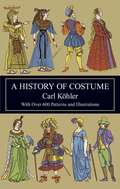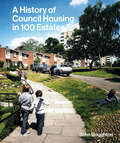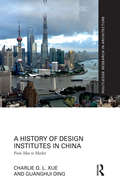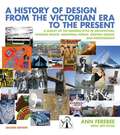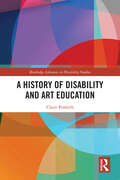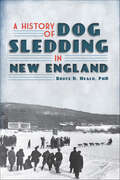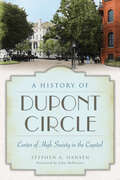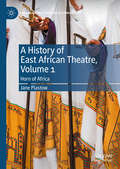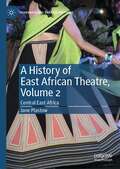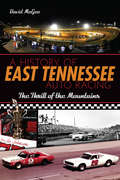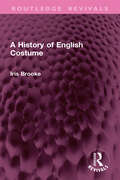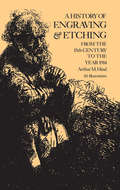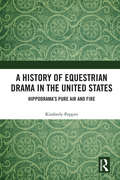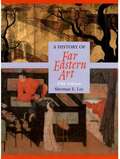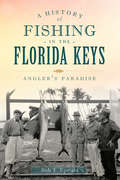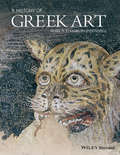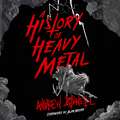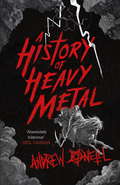- Table View
- List View
A History of Contemporary Chinese Art: 1949 to Present (Chinese Contemporary Art Series)
by Yan ZhouChinese art has experienced its most profound metamorphosis since the early 1950s, transforming from humble realism to socialist realism, from revolutionary art to critical realism, then avant-garde movement, and globalized Chinese art. With a hybrid mix of Chinese philosophy, imported but revised Marxist ideology, and western humanities, Chinese artists have created an alternative approach – after a great ideological and aesthetic transition in the 1980s – toward its own contemporaneity though interacting and intertwining with the art of rest of the world. This book will investigate, from the perspective of an activist, critic, and historian who grew up prior to and participated in the great transition, and then researched and taught the subject, the evolution of Chinese art in modern and contemporary times. The volume will be a comprehensive and insightful history of the one of the most sophisticated and unparalleled artistic and cultural phenomena in the modern world.
A History of Contemporary Stage Combat: 1969 - Today
by Brian LeTraunikA History of Contemporary Stage Combat chronicles the development of stage combat from the origins of the Society of British Fight Directors in 1969 to the modern day. Featuring interviews with some of the pioneers of this art form, the book analyzes how stage combat developed in response to the needs of the industry and the changing social mores in the United States, United Kingdom, Canada, the European Continent, Australia, and New Zealand. It also explores the quality of theatrical weaponry, as well as outcropping of stage combat such as intimacy design and theatrical jousting. A History of Contemporary Stage Combat is an excellent resource for actors, directors, stage combatants, theatre historians, and anyone with a love of action on stage and film.
A History of Costume (Dover Pictorial Archive Ser.)
by Carl KöhlerEgypt, Babylon, Greece up through 19th-century Europe; based on surviving pieces, art work, much more. Includes many clear, measured patterns for reproducing historic costumes. Full text. 595 illustrations. .
A History of Council Housing in 100 Estates
by John Boughton‘It was like heaven! It was like a palace, even without anything in it … We’d got this lovely, lovely house.’ In 1980, there were well over 5 million council homes in Britain, housing around one third of the population. The right of all to adequate housing had been recognised in the 1948 Universal Declaration of Human Rights, but, long before that, popular notions of what constituted a ‘moral economy’ had advanced the idea that everyone was entitled to adequate shelter. At its best, council housing has been at the vanguard of housing progress – an example to the private sector and a lifeline for working-class and vulnerable people. However, with the emergence of Thatcherism, the veneration of the free market and a desire to curtail public spending, council housing became seen as a problem, not a solution. We are now in the midst of a housing crisis, with 1.4 million fewer social homes at affordable rent than in 1980. In this highly illustrated survey, eminent social historian John Boughton, author of Municipal Dreams, examines the remarkable history of social housing in the UK. He presents 100 examples, from the almshouses of the 16th century to Goldsmith Street, the 2019 winner of the RIBA Stirling Prize. Through the various political, aesthetic and ideological changes, the well-being of community and environment demands that good housing for all must prevail. Features: 100 examples of social housing from all over the UK, illustrated with over 250 images including photographs and sketches. A complete history, dating from early charitable provision to ‘homes for heroes’, garden villages to new towns, multi-storey tower blocks and modernist developments to contemporary sustainable housing. Iconic estates, including: Alton East and West, Becontree, Dawson’s Heights, Donnybrook Quarter, Dunboyne Road and Park Hill. Projects from leading architects and practices, including: Peter Barber, Neave Brown, Karakusevic Carson, Kate Macintosh and Mikhail Riches.
A History of Design Institutes in China: From Mao to Market (Routledge Research in Architecture)
by Charlie Q. Xue Guanghui DingA History of Design Institutes in China examines the intricate relationship between design institutes, the state, and, in later periods, the market economy through a carefully situated discussion of significant theoretical and historical issues including socialist utopia, collective and individual design, structural transformation, and architectural exportation, amongst others. It shows how, over the past six decades, China’s design institutes have served the state’s strategy for socialist construction and urbanisation to create socioeconomic and cultural value. Through first-hand research, authors Xue and Ding reveal how the tensions between pragmatism, creativity, collaboration, and resistance have played a crucial role in defining architectural production. Appealing to academics, researchers, and graduate students, this book provides a much-needed contribution to the discourse on architectural history, building practices, and policymaking in contemporary China.
A History of Design from the Victorian Era to the Present
by Jeff Byles Ann FerebeeA unique cross-disciplinary survey of design history, A History of Design from the Victorian Era to the Present offers a concise overview of the modern milestones of architecture, interior design, graphic design, product design, and photography from the Crystal Palace of 1851 to the iPhone at the turn of the twenty-first century.
A History of Disability and Art Education (Routledge Advances in Disability Studies)
by Claire PenkethDrawing on recent theoretical frameworks from critical disability studies and art education including normalcy, ableism, disability and Crip theory, this book offers an analysis of the conceptualisation of ability in art education and its relationship with disability. Drawing on the work of Cizek and Lowenfeld in Austria, Ruskin and Richardson in England and Dewey and Eisner in the United States, it critically examines the influence of ideas such as the dominance of vision and visuality; the emergence of psychological perspectives; the Child Art Movement; the implications of assessment regimes; and the relevance of art education as a critical social practice on the production of disability. Offering a sustained inquiry into the differential values attributed to learners and their work and the implications of this for framing our understanding of disability in art education, this book shows that although art educators have frequently advocated for the universal appeal and importance of art education, they have done so within historical contexts that have produced and determined problematic ideas regarding disability. It will be of interest to all scholars and students of disability studies, art in education, art history and education studies.
A History of Dog Sledding in New England (Sports)
by Bruce D. Heald PhDSled dogs trot through expanses of sparkling white snow, pulling a musher and energetically surging with the command, "Let's go!" From puppies to seasoned competitors, sled dogs partner with mushers in a passionate pursuit of a great racing tradition. The renowned and formidable Laconia World Championship Sled Dog Derby, the New England Sled Dog Club and famous drivers like Dr. Charles Belford--who came in fifth place at Laconia at the age of seventeen--helped solidify the fame of New England sled dog trails. Historian Bruce D. Heald celebrates the best of the sport in the region, from the feats of legendary Arthur Walden and his famous Chinook dogs to the Siberian huskies' contribution to the World War II effort. Join Heald as he charts the legacy of this remarkable sport.
A History of Dupont Circle: Center of High Society in the Capital (Landmarks Ser.)
by Stephen A HansenDuring the Gilded Age, Dupont Circle was Washington's undisputed center of wealth, power and status. Over twenty years, it evolved from small farms and an overrun city cemetery to a community of grand homes for society's elite. Residents included future president William Taft, inventor Alexander Graham Bell, newspaper publisher Cissy Patterson and many more. From the intimate dinners and receptions of the Cave Dwellers to the lavish balls of Mary Townsend and others in the "smart set," Dupont Circle marked each social season in the capital. Satirized in Mark Twain's novel "The Gilded Age," the nouveau riche lifestyle of Dupont Circle was fodder for newspaper celebrity gossip. Author Stephen Hansen brings to life the intriguing history of Washington's famed Dupont Circle.
A History of East African Theatre, Volume 1: Horn of Africa (Transnational Theatre Histories)
by Jane PlastowThis book is the first ever transnational theatre study of an African region. Covering nine nations in two volumes, the project covers a hundred years of theatre making across Burundi, Djibouti, Eritrea, Ethiopia, Kenya, Rwanda, Somalia, Tanzania, and Uganda. This volume focuses on the theatre of the Horn of Africa. The book shows how the theatres of Djibouti, Eritrea, Ethiopia, and Somalia, little known in the outside world, have been among the continent's most politically important, commercially successful, and widely popular; making work almost exclusively in local languages and utilizing hybrid forms that have privileged local cultural modes of production. A History of African Theatre is relevant to all who have interests in African cultures and their relationship to the history and politics of the East African region.
A History of East African Theatre, Volume 2: Central East Africa (Transnational Theatre Histories)
by Jane PlastowThis second volume of A History of East African Theatre focuses on central East Africa; on Burundi, Kenya, Rwanda, Tanzania and Uganda. The first chapter is concerned with francophone theatres, comparatively studying work coming out of Burundi and Rwanda alongside a focus on French language theatre in Djibouti. The chapter is particularly concerned to explore how French and Belgian cultural policies impacted theatre during the colonial period and how the French ideas of Francafrique and promotion of elite, French language art have continued to resonate in the post-colonial present. Chapters Two and Three look comparatively at the rich theatre histories of Kenya, Tanzania and Uganda, and are divided between a study of British East African colonial impact and an analysis of the post-colonial period illustrating how divergent political thought and societal make-up led to exponential differentiation in national theatres. The final chapter, on Theatre for Development and related social action theatre, covers the whole East African region, offering the first ever historicised analysis of this mode of theatre making which, since the 1980s, has come to dominate funding and opportunity in performance arts.
A History of East Tennessee Auto Racing: The Thrill of the Mountains (Sports)
by David McgeeEast Tennessee isn't typically mentioned among stock car racing's formative hotbeds. But the region from Bristol to Oneida and Chattanooga encapsulates a significant portion of the sport's history. From pioneers like Brownie King and Paul Lewis of Johnson City to former national champions Joe Lee Johnson of Chattanooga and L.D. Ottinger of Newport, East Tennessee has produced many of NASCAR's great drivers. The region is home to one of the world's largest sports stadiums in the Bristol Motor Speedway, but NASCAR also made regular visits to other area tracks. Whether the surface is red clay, asphalt or brushed concrete, East Tennessee still boasts some of the world's fastest, most competitive racing. Join author and racing insider David McGee as he presents a vast array of colorful characters whose passion fueled a sport that has gone from primitive to prime time.
A History of English Costume (Routledge Revivals)
by Iris BrookeOriginally published in 1937 and reprinted as a fourth edition in paperback in 1979, this is a history of dress in England from the Norman Conquest to the mid-20th century. Despite being an excellent resource for the student or designer, this book also provides a wealth of material for the social historian. Indeed, the author argues that costume is important because it is custom, and custom and habit have helped to shape history just as much as political machinations and geographical discoveries.
A History of Engraving and Etching
by Arthur M. HindArthur Mayger Hind (1880–1957) was a leading historian of engraving, one of the most highly respected art historians of modern times. Keeper of Prints and Drawings at the British Museum and Professor of Fine Art at Oxford, he was the author of the most complete history of etching and engraving that has yet been written. This book, formerly out of print for many years, contains references to every etcher or engraver worthy of mention from the early fifteenth century to 1914, and it gives a fair account of influences, artistic repercussions, and accomplishments of each individual.Beginning with a chapter on processes and methods of the twin arts, in which he covers line-engraving, etching, biting and stopping-out, tone processes, the tools used in the various methods, and so on, the author proceeds with a text that is fabled among artists, art historians, teachers, and students for its richness of detail and the brilliance of its author’s obvious genius for research and criticism. He begins with the anonymous engravers of the fifteenth century, moves through Holland, Italy, and Germany to the great masters of engraving and the beginnings of etching in the sixteenth century, through the portrait engravers, master etchers, the practitioners of mezzotint, aquatint, crayon manner and stipple, and color print makers, to modern etching in the period prior to World War I. All along the way there are illustrations: over 100 magnificent works by Dürer, Finiguerra, Cranach, Lucas Van Leyden, Parmigiano, Van Dyck, Rembrandt, van Ruysdael, Blake, Tiepolo, Piranesi, Turner, Boucher, Goya, Millet, Whistler, and scores of others. All but seven of these plates have been reproduced from new photographs and are even sharper and clearer than those in the original editions of Hind's great text.As an aid to students of art history, there is a massive Index of more than 2,500 artists mentioned in the text, with their dates and brief individual biographical data. Furthermore, there is a classified chronological list, arranged by country, of important artists, movements, and styles, and the engravers and etchers who were influenced by them. Finally, there is a bibliography that is valuable for further reference work.
A History of Equestrian Drama in the United States: Hippodrama’s Pure Air and Fire
by Kimberly PoppitiA History of Equestrian Drama in the United States documents the history of equestrian drama in the United States and clarifies the multi-faceted significance of the form and of the related stage machinery developed to produce hippodramas. The development of equestrian drama is traced from its origins and influences in the sixteenth century, through the height of the form’s popularity at the turn of the twentieth century. Analysis of the historical significance of the genre within the larger context of U.S. theatre, the elucidation of the importance of the horse to theatre, and an evaluation of the lasting impact on theatre technology are also included.
A History of Far Eastern Art
by Sherman E. Lee Naomi Noble RichardCovers Himalayan areas--Ladakh, Kashmir, Tibet, and Nepal. New chronologies in Stone age and Bronze Age, China, Korea, and Japan.
A History of Fishing in the Florida Keys: Angler's Paradise (Sports)
by Bob T. EpsteinSince the arrival of Ponce de Leon in the 1500s, the Florida Keys have evolved from a dense, nearly impenetrable jungle full of bears, pumas, snakes, alligators and crocodiles into America's Caribbean islands. And the fish in the region have made the Keys one of the nation's favorite playgrounds for anglers. The Keys are home to more saltwater fishing records than any other angling destination in the world and offer sportsmen an array of amazing fish, from tarpon and Spanish mackerel to mahi-mahi and bonefish. U.S. presidents, celebrities and the world's greatest fishermen and women have cruised the waters of South Florida. Join author Bob T. Epstein on a journey through the storied history of fishing in the Florida Keys.
A History of Ghosts: The True Story of Séances, Mediums, Ghosts, and Ghostbusters
by Peter H. Aykroyd Angela NarthPeter Aykroyd spent his childhood watching his family's parlor séances through the crack of a basement door. Here, for the first time, Aykroyd tells the strange and delightful story that inspired his son, Dan, to make the mega-hit, Ghostbusters. Part history, part family legend, A History of Ghosts starts in 1848 in upstate New York, where the spiritualist craze first began. Aykroyd introduces the reader to notable mediums while telling the story of the development of spiritualism, interweaving a personal history marked by a fascination with ghosts and spirits with the larger narrative about the role the paranormal has played in our culture. Such legendary figures as Sir Arthur Conan Doyle and Harry Houdini appear and vanish. Everyone loves a good ghost story. Successful TV shows such as Medium and Ghost Hunters are proof that our national obsession with ghosts is here to stay. Millions of Americans believe in the paranormal—and even skeptics have heard a bump in the night and suspected it might be something supernatural.
A History of Golf in Georgia (Sports)
by John CompaniotteGolf first came to Georgia in the late eighteenth century when a group of avid golfers banded together to form a club in Savannah. By the end of the nineteenth century, when the game had become popular, the state developed courses from border to border. More than four hundred courses now dot the landscape of the Peach State. Georgia native and golfing icon Bobby Jones won four of golf's most coveted titles in 1930: the British Amateur, British Open, U.S. Open and U.S. Amateur. For one hundred years, the state has produced champion golfers at every level, hosted amateur and professional championships and provided support for the global sport. Author John Companiotte offers the compelling story of golf's rise and prosperity in Georgia.
A History of Greek Art
by Mark D. Stansbury-O'DonnellOffering a unique blend of thematic and chronological investigation, this highly illustrated, engaging text explores the rich historical, cultural, and social contexts of 3,000 years of Greek art, from the Bronze Age through the Hellenistic period. Uniquely intersperses chapters devoted to major periods of Greek art from the Bronze Age through the Hellenistic period, with chapters containing discussions of important contextual themes across all of the periods Contextual chapters illustrate how a range of factors, such as the urban environment, gender, markets, and cross-cultural contact, influenced the development of art Chronological chapters survey the appearance and development of key artistic genres and explore how artifacts and architecture of the time reflect these styles Offers a variety of engaging and informative pedagogical features to help students navigate the subject, such as timelines, theme-based textboxes, key terms defined in margins, and further readings. Information is presented clearly and contextualized so that it is accessible to students regardless of their prior level of knowledge A book companion website is available at www.wiley.gom/go/greekart with the following resources: PowerPoint slides, glossary, and timeline
A History of Heavy Metal
by Andrew O'NeillThe history of heavy metal brings brings us extraordinary stories of larger-than-life characters living to excess, from the household names of Ozzy Osbourne, Lemmy, Bruce Dickinson and Metallica (SIT DOWN, LARS!), to the brutal notoriety of the underground Norwegian black metal scene and the New Wave Of British Heavy Metal. It is the story of a worldwide network of rabid fans escaping everyday mundanity through music, of cut-throat corporate arseholes ripping off those fans and the bands they worship to line their pockets. <p><p>The expansive pantheon of heavy metal musicians includes junkies, Satanists and murderers, born-again Christians and teetotallers, stadium-touring billionaires and toilet-circuit journeymen. Award-winning comedian and life-long heavy metal obsessive Andrew O'Neill has performed his History of Heavy Metal comedy show to a huge range of audiences, from the teenage metalheads of Download festival to the broadsheet-reading theatre-goers of the Edinburgh Fringe. <p><p>Now, in his first book, he takes us on his own very personal and hilarious journey through the history of the music, the subculture, and the characters who shaped this most misunderstood genre of music.
A History of Heavy Metal: 'Absolutely hilarious' – Neil Gaiman
by Andrew O'Neill'Absolutely hilarious' - Neil Gaiman'One of the funniest musical commentators that you will ever read . . . loud and thoroughly engrossing' - Alan Moore'A man on a righteous mission to persuade people to "lay down your souls to the gods rock and roll".' - The Sunday Times'As funny and preposterous as this mighty music deserve' - John HiggsThe history of heavy metal brings brings us extraordinary stories of larger-than-life characters living to excess, from the household names of Ozzy Osbourne, Lemmy, Bruce Dickinson and Metallica (SIT DOWN, LARS!), to the brutal notoriety of the underground Norwegian black metal scene and the New Wave Of British Heavy Metal. It is the story of a worldwide network of rabid fans escaping everyday mundanity through music, of cut-throat corporate arseholes ripping off those fans and the bands they worship to line their pockets. The expansive pantheon of heavy metal musicians includes junkies, Satanists and murderers, born-again Christians and teetotallers, stadium-touring billionaires and toilet-circuit journeymen. Award-winning comedian and life-long heavy metal obsessive Andrew O'Neill has performed his History of Heavy Metal comedy show to a huge range of audiences, from the teenage metalheads of Download festival to the broadsheet-reading theatre-goers of the Edinburgh Fringe. Now, in his first book, he takes us on his own very personal and hilarious journey through the history of the music, the subculture, and the characters who shaped this most misunderstood genre of music.
A History of Heavy Metal: 'Absolutely hilarious' – Neil Gaiman
by Andrew O'Neill'Absolutely hilarious' - Neil Gaiman'One of the funniest musical commentators that you will ever read . . . loud and thoroughly engrossing' - Alan Moore'Relentlessly energetic and frequently hilarious' - The Herald'A man on a righteous mission to persuade people to "lay down your souls to the gods rock and roll"' - The Sunday Times'A love letter to Heavy Metal' - BBC RADIO 4 'As funny and preposterous as this mighty music deserve' - John HiggsThe history of heavy metal brings brings us extraordinary stories of larger-than-life characters living to excess, from the household names of Ozzy Osbourne, Lemmy, Bruce Dickinson and Metallica (SIT DOWN, LARS!), to the brutal notoriety of the underground Norwegian black metal scene and the New Wave Of British Heavy Metal. It is the story of a worldwide network of rabid fans escaping everyday mundanity through music, of cut-throat corporate arseholes ripping off those fans and the bands they worship to line their pockets. The expansive pantheon of heavy metal musicians includes junkies, Satanists and murderers, born-again Christians and teetotallers, stadium-touring billionaires and toilet-circuit journeymen. Award-winning comedian and life-long heavy metal obsessive Andrew O'Neill has performed his History of Heavy Metal comedy show to a huge range of audiences, from the teenage metalheads of Download festival to the broadsheet-reading theatre-goers of the Edinburgh Fringe. Now, in his first book, he takes us on his own very personal and hilarious journey through the history of the music, the subculture, and the characters who shaped this most misunderstood genre of music.
A History of Hispanic Theatre in the United States: Origins to 1940
by Nicolás KanellosHispanic theatre flourished in the United States from the mid-nineteenth century until the beginning of the Second World War—a fact that few theatre historians know. A History of Hispanic Theatre in the United States: Origins to 1940 is the very first study of this rich tradition, filled with details about plays, authors, artists, companies, houses, directors, and theatrical circuits.<P><P>Sixteen years of research in public and private archives in the United States, Mexico, Spain, and Puerto Rico inform this study. In addition, Kanellos located former performers and playwrights, forgotten scripts, and old photographs to bring the life and vitality of live theatre to his text. He organizes the book around the cities where Hispanic theatre was particularly active, including Los Angeles, San Antonio, New York, and Tampa, as well as cities on the touring circuit, such as Laredo, El Paso, Tucson, and San Francisco.
A History of Honey in Georgia and the Carolinas (American Palate)
by April AldrichIn the late 1800s, Georgia and the Carolinas produced millions of pounds of honey and created a lasting legacy within the industry. The uses for the sweet nectar go well beyond flavor. Bee pollination extensively benefits agricultural crops in the area. Elements from the beehive are commonly used in popular cosmetics, medicines and mead. Beekeepers also face serious challenges like Colony Collapse Disorder. Join author and beekeeper April Aldrich as she traces the delectable history of honey and beekeeping throughout the region, from ancient apiaries to modern meaderies and beyond.

